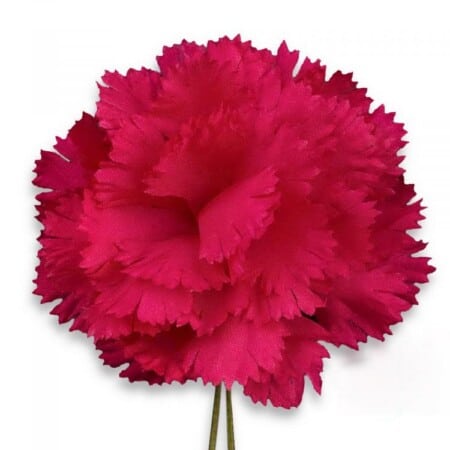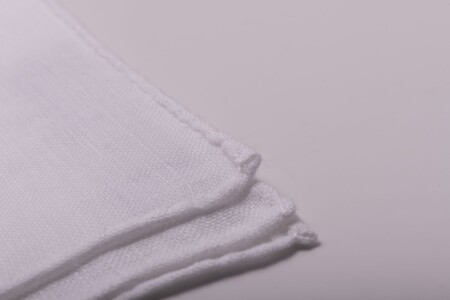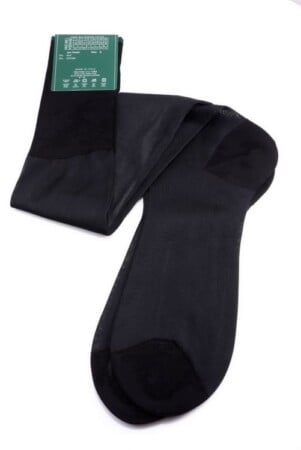Origins of the Tuxedo Shirt: A Tale of Two Collars
Once upon a time, the dinner jacket was born as the informal offspring of the majestic tailcoat and had no accessories to call its own. For many years, it borrowed the stiff-front wing-collar shirt from its full-dress parent. Then the jacket came of age in the glorious sartorial days of the 1930s with a unique dress code that included a soft-front shirt with a turndown collar. This soon became the standard black-tie shirt and remained so until a very dark time known as the seventies when an evil imposter appeared: the ruffled tuxedo shirt.

The Original Wing-Collar Shirt with Detachable Collar
The Full-Dress Original
With its tall, starched detachable wing collar and stiff, plain bosom, this classic shirt radiates the elegance and gentility of a nobler era and imbues the most ordinary of men with an aristocratic air. Complete details of this princely garment can be found in the White Tie section.
Originally, the white stiff front shirt used to be the only evening shirt option for men. Despite being rarely seen with black tie since the 1940s, some sartorial authorities such as Alan Flusser advise that this option remains perfectly acceptable today, although it should be limited to the very formal single-breasted peaked-lapel jacket. It can be paired with a black or matching white marcella evening waistcoat.

If you wear a boiled front or marcella pique front shirt, make sure to wear an undershirt to avoid chaffing. Also, ensure to get a properly sized black bow tie or a single end bow tie so no clasp is visible. Moreover,you will need shirt studs to fasten the collar to the shirt, and you can usually find those at the same places you buy the collars or vintage. For more information about buying tuxedo shirts, please take a look at our buying guide.
The Modern Reinvention: Attached Wing Collar Shirt
In the 1960s American manufacturers created the attached collar version of the wing-collar shirt. At first, it maintained the traits of the original stiff front but by the late 1970s, it was featuring soft pleated fronts with minuscule wings. This modern and much-maligned incarnation is described in depth in the Contemporary Black Tie section.

A New Contender: The Turndown Collar Shirt
A New Trend in Evening Shirts
Popularized in the early 1930s by the future Duke of Windsor, turndown collar dinner shirts offered a more comfortable and practical alternative to the cardboard-stiff full-dress model in that they were softer, did not require extensive starching and laundering and could be buttoned in front instead of in the back. Initially considered too informal for any occasion outside of summer, they soon became the black-tie shirt of choice following World War II.
Materials and Construction
The body of a soft evening shirt is typically constructed of a thin fabric that provides maximum breathability such as fine broadcloth, poplin, batiste or voile. The turndown collar can either be spread or semi-spread as shown in the picture above. The spread version is more formal and because its tips are hidden under the jacket lapels it is well suited for the streamlined shawl-collar. The sleeves of soft-front shirts always carry French cuffs, or double cuffs, as they are known in the United Kingdom.

The final visible portion of the shirt, the bosom, is a bib-shaped or vertically rectangular double layer of fabric unique to formal shirts. The bosom is traditionally decorated with pleats or piqué. For the first option, wide or “box” pleats were the most common style during the 1930s but the narrow pleats that are so popular today have been around since the 1940s. A dressier alternative was devised by London shirtmakers of the 1930s who decorated the bosom, cuffs, and collars with the piqué normally associated with the full-dress shirt. This combination is commonly known as a Marcella shirt after the British term for the birdseye pattern that is used in the piqué.
Black-tie shirts are traditionally closed with two to three studs depending on the wearer’s height although it should be noted that some classic etiquette authorities limited studs to stiff-front shirts only and prescribed pearl buttons for soft-front models instead. Bosoms can be unstarched (“soft-front”) or lightly starched (“semi-stiff”). Also, modern shirts often feature 4 stud holes, whereas more contemporary tuxedo shirts have a hidden fly without any studs. Learn more about contemporary tuxedo shirts here.
In the latter case, the bib should end above the waistline to prevent it from billowing out when the wearer sits down. And to keep either type of shirt front from pulling out of the trousers when the wearer stands up, higher-end models will have a tab that attaches to a button on the inside of the trouser waistband, as shown in the picture below. Like the bottom of the shirt’s bib, the tab is hidden by the formal waist covering.
There are no pockets on formal shirts as they are not considered dressy and would interfere with the reinforced bosom.
Formal Facts

Voile Shirts: Unveil Excellence
One of the most popular classic fabrics for a tuxedo shirt is voile, a soft, sheer fabric usually made from cotton or blends of cotton and linen or cotton and synthetics. Its name is derived from the French word for “veil.” With its light weight and unique sheen, voile provides maximum comfort and breathability beneath your jacket. Note that the visible features of the shirt, like the bib, collar, and cuffs, are made from a thicker material than the sheer body, often marcella.

Semi-Classic: A More Casual Tuxedo Shirt Alternative
If you desire a more informal look for your tuxedo shirt, you do have options. Buttoned plain-front black-tie shirts have been popular for decades and are acceptable for Black Tie ensembles. In fact, according to a 1948 etiquette book, these shirts were the most popular variety of Tuxedo Shirt at the time, although they were expected to feature pearl buttons.
What’s in a Name? “Wing Collar” vs. “Wing Tip”
In closing, remember that “Wing Collar” refers to a shirt collar type, while “Wing Tip” refers to type of shoe. Believe it or not, some mainstream formal wear retailers do not know the difference. Learn more about brogues and wingtips here.
Elevate Your Evening Shirt with the Perfect Cufflinks
Explore this chapter: 4 Classic Black Tie – The Gold Standard
- 4.1 Classic Tuxedo – Dinner Suits
- 4.2 Classic Evening Waistcoats, Vests, & Cummerbunds
- 4.3 Classic Tuxedo Shirts
- 4.4 Classic Neckwear – The Black Bow Tie
- 4.5 How To Find The Right Black Bow Tie For Your Tux and Face
- 4.6 Classic Tuxedo Shoes – Patent Leather Oxfords & Pumps
- 4.7 Classic Accessories – Cufflinks, Studs & Co
- 4.8 Classic Black Tie Outerwear
- 4.9 Warm-Weather Black Tie – The (Off) White Dinner Jacket
- 4.10 Classic Tuxedo Alternatives – How To Stand Out in Black Tie
- 4.11 Non-Traditional Dinner Jacket Guide







